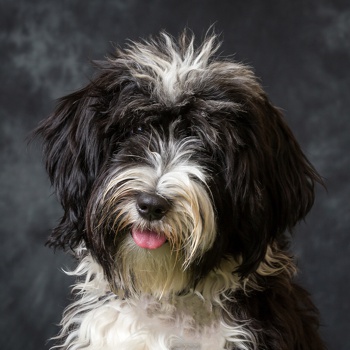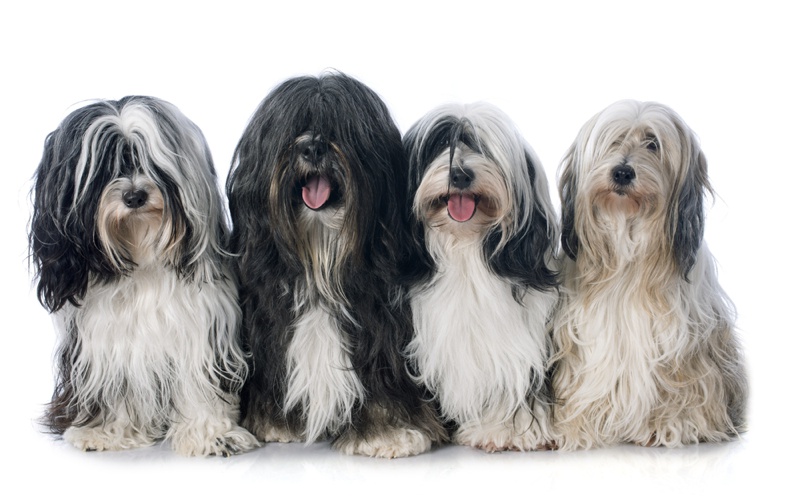Tibetan Terrier

Legend has it that selling or mistreating a Tibetan Terrier would incur a lifetime of bad luck, but thankfully, modern breeders seem to have largely avoided this fate, for this is an enduringly popular breed in the United Kingdom and elsewhere. Known as the “Holy Dog of Tibet”, it is not, in fact, a terrier at all, but primarily an adaptable companion dog that can happily live either a relatively sedentary urban lifestyle or an active, outdoorsy rural one. Used by Tibetan lamas as a watch dog and for other assorted chores, it is an alert breed that is reserved with strangers, and it possesses a high level of intelligence. Its gentle, affectionate nature requires the same characteristics of its owners, and it needs plenty of human contact, being prone to anxiety if left alone.
Tibetan Terriers make excellent pets for older kids, but can become somewhat nervy if constantly bothered by younger children, so they are best suited to homes without toddlers. Each has its own very individual personality, with some being a little stubborn; however, they are generally quite easy to train to a high level, and the breed frequently figures prominently in obedience trials and other competitive events. Although the long double coat requires quite a bit of attention during puppyhood and adolescence, it eventually needs very little input, and sheds only lightly, adding to the appeal of this charming pedigree. Unfortunately, however, the Tibetan Terrier does suffer from a number of health problems that prospective owners should be aware of; nonetheless, it has a respectable life expectancy of 12 to 14 years.
About & History
While the Western world remained largely unaware of the existence of the breed until less than a hundred years ago, the Tibetan Terrier has graced the villages and monasteries of Tibet for many centuries. In fact, many cynologists consider this one of the very oldest of the modern breeds. In its native setting, it was used for a range of jobs; primarily a watchdog, it was also valued as a pet, and often helped in herding sheep and goats in the mountainous landscape. One of the more unusual of its responsibilities was the retrieval of objects inadvertently dropped down a mountainside by its owner! The Tibetan Terrier enjoys an elevated position in Tibetan society, and is known as the “Holy Dog of Tibet”. Because of the bad luck thought to be associated with selling such a venerated animal, one could be acquired only as a gift. It is largely for this reason that it remained confined within a small geographical area for so long.
Thankfully, for the rest of the world, in 1922, Dr. Agnes Greig, an Englishwoman, administered life-saving treatment to a Tibetan patient, and was gifted a female Tibetan Terrier (which she named “Bunti”) by the patient’s grateful husband. After her return to England, Dr. Grieg managed to acquire a male, also as a gift, named “Rajah”, allowing her to commence the first breeding programme outside of Tibet. Unsure how to classify this novel breed, the Kennel Club registered the first litters as Lhasa Terriers, but later followed the lead of the Indian Kennel Club by changing the name to Tibetan Terrier, despite the breed’s many differences from any of the extant terrier breeds. Today, the breed is classified under the utility group, but its name has remained unchanged.
Appearance

Under its impressively long, hard-wearing coat, the Tibetan Terrier is a strong and compact dog, small to medium in size, of square proportions. It is often said to resemble the Old English Sheepdog in miniature, and has the moderately broad, slightly domed skull and strong square muzzle also seen in this larger breed. It has dark, expressive eyes that are set quite far apart, and high-set triangular ears that fold to the side of the head.
Although I never fail to be surprised at how light a dog lies hidden in the profuse hair-coat, Tibetan Terriers nonetheless have very muscular bodies, a strong neck, and athletic limbs. The chest is reasonably deep and quite broad. The tail, always a reliable indicator of the dog’s state of mind, is carried in a curl over the back, with generous feathering that ripples as it wags. The thick, double coat is very slow growing, and takes around 18 months to reach its ultimate length, which is considerable. The furnishings around the face create a moustache, beard, and extremely long fringe. The coat colour may be:
- White
- Golden
- Cream
- Grey
- Black
- Any mixture of the above
Tibetan Terriers can vary quite a bit in their size and weight, but most males measure 36 to 41 cm in height, and weigh 9 to 11 kg. Females range from 34 to 38 cm in height, and weigh 8 to 10 kg.
These are dogs that adapt to whatever is going on around them – in the park, they are fun-loving, energetic, and playful; while after a long day they are equally content to settle at their owner’s feet and relax. Like most breeds, the Tibetan Terrier can be hyperactive and skittish in puppyhood, but it is generally a laid-back and easy-going adult. Throughout their lives, they retain a natural suspicion of strangers, but are never aggressive. This is reflected in the breed’s excellent abilities as a guard dog, but its willingness to bark at every little sound does need to be controlled to prevent this becoming a problem behaviour.
Character & Temperament
These are dogs that adapt to whatever is going on around them – in the park, they are fun-loving, energetic, and playful; while after a long day they are equally content to settle at their owner’s feet and relax. Like most breeds, the Tibetan Terrier can be hyperactive and skittish in puppyhood, but it is generally a laid-back and easy-going adult.
Throughout their lives, they retain a natural suspicion of strangers, but are never aggressive. This is reflected in the breed’s excellent abilities as a guard dog, but its willingness to bark at every little sound does need to be controlled to prevent this becoming a problem behaviour.
Trainability
This is one of the breeds most suitable for an inexperienced owner, as Tibetan Terriers are clever dogs that have an intuitive understanding of their owner’s wishes. Although some can be a little stubborn at times, this can generally be overcome with plenty of encouragement and a little patience. Socialisation is important, especially during puppyhood, when positive experiences of meeting new people can help build the young dog’s confidence around strangers.
Health
There is a reasonably high incidence of breed-associated health disorders in the Tibetan Terrier; however, many of these affect the eyes rather than general health, and there are now excellent screening programmes in place under the auspices of the Kennel Club and the British Veterinary Association that can give buyers confidence that their pup is unlikely to be afflicted by any of these problems.
Cataract
A hereditary form of cataract development is seen in the breed, with affected dogs having early signs at around one year of age. These early onset cataracts often progress to cause significant visual impairment by four to five years of age.
Diabetes Mellitus
Common hormone disorder in this and several other breeds. Occurs as a result of autoimmune damage to the pancreas, reducing the organ’s capacity to secrete insulin and necessitating the administration of regular injections to manage blood glucose levels.
Glaucoma
Impaired fluid drainage from the eye, causing intraocular pressure to rise, which leads to enlargement of the eye, pain, and loss of vision.
Lysosomal Storage Disease
Thankfully rare, a genetic abnormality leading to profound, progressive neurological problems in young adults.
Lens Luxation
Weakening of the structure within the eye responsible for suspending the lens, which allows the lens to fall out of position, causing significant visual impairment.
Progressive Retinal Atrophy
The most common cause of blindness in many breeds, this is most often an inherited disorder that manifests at around four to five years of age, first as night blindness, but usually progressive to more profound sight loss.
Exercise and Activity Levels
Tibetan Terriers are athletically built, and are capable of sustaining a fast trot for long spells, meaning that most make able companions for joggers and casual cyclists. However, under different circumstances, they are also happy to take life at a slower pace, and they make excellent, well-mannered apartment dogs, as long as they are given a twenty to thirty minute walk twice daily.
Grooming
The breed has quite an unusual coat, in that it is soft and downy for the first few months of life, growing to a reasonable length, and then undergoes a spectacular moult, usually around eight months of age, before regrowing as the slightly harsher adult coat. After this first heavy moult, it sheds lightly, as hair growth and turnover are remarkably slow. It is this slow turnover that allows the Tibetan Terrier’s coat to grow to its great length by around two years of age.
Younger dogs need daily brushing to tame the hair, but once it has reached close to its full length, it will generally remain tangle-free with weekly grooming sessions. Although it can be allowed to remain long, many owners elect to have the Tibetan’s hair clipped two to three times a year, as they find it easier to manage, especially around the face, where the beard needs regular cleaning after the dog has eaten.
Famous Tibetan Terriers
There are surprisingly few of these little dogs that have made it into the glare of the media, although both Lesley Nicol (of Downton Abbey) and Clare Balding are known to have been proud Tibetan Terrier owners.
Cross-Breeds
The Tibetan Terrier has spawned several popular designer dog mixes:
- Cobetan – Cross between a Tibetan Terrier and a Cocker Spaniel
- Tibecot – Cross between a Tibetan Terrier and a Coton de Tulear
- Tibepillon Terrier – Cross between a Tibetan Terrier and a Papillon
- Toodle – Cross between a Tibetan Terrier and a Poodle

